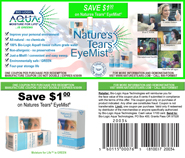
June 8, 2011
Preventing and Lessening Eye Injuries
Eye Protection and Emergency First Aid
Note: According to the Merriam-Webster Medical Dictionary (1995), "to injure" is defined as, "to impair the soundness of." Based on this extremely broad definition, the term "eye injury," as used by eye care and emergency professionals, can refer to conditions ranging from the mildly uncomfortable (soap in the eye or squinting due to air pollution) to catastrophic trauma (eye penetration by a foreign object).
Eyesight Threats.
" In an emergency, eyesight threats may arise from smoke, heat, dust, fumes, airborne chemicals and particles, perspiration into the tear film, tear gas and pepper spray, mechanical injuries and impact trauma from flying objects. Injuries from of these threats may often be prevented or lessened through good eye safety practices.
" Eyesight threats may also be present in non-emergency situations. They could be caused by cleaning fluid fumes, auto exhaust, slicing onions, prolonged computer use, perspiration into the tear film, an eyelash in the eye, home shop accidents, and even insulated windows and walls and forced-air heating and cooling (which can be dehydrating to the eye's protective tear film). These injuries may also be prevented or mitigated with good eye safety practices.
" Unprotected exposure to these eyesight threats could result in consequences ranging from mild eye discomfort to serious and permanent eye damage. Symptoms could include blurred or impaired vision, pain, dehydration (dry eye), eye strain; burning, itchy or watery eyes; eye diseases and serious physical injury (catastrophic trauma). Symptoms may be mild (sub-acute) or temporarily disorienting, or they could result in permanent eye damage and eyesight impairment or loss.
Eye Protection and First Aid.
- Remember that in an emergency such as a burning building, impaired eyesight from dust, smoke, fumes or perspiration, could make it more difficult or impossible to get out and could cost you your life.
- Healthy, well hydrated eyes will serve you far better in an emergency. It pays to educate yourself about eye care and practice good eye health on a daily basis.
- Before engaging in an activity where eye injuries could occur, always:
- Know what to do in an emergency.
- Have a predetermined emergency first aid plan for eye and other injuries.
- Follow good safety precautions and procedures.
- Have emergency first aid materials available.
- The best way to prevent eye injuries, especially from foreign objects and harmful substances, is to wear protective eyewear when in high risk situations. If you have corrective lenses, you are less likely to have an accident if you wear them.
- Chronically dehydrated eyes, which lack sufficient moisture (water) in the protective overlying tear film, are more susceptible to certain eye injuries than fully hydrated eyes.
Specific Situations.
Fumes, smoke, tear gas, pepper spray, airborne chemicals. These conditions can make it difficult or impossible to see in an emergency and may cause permanent damage. They can also create discomfort by altering the tear film's pH (acidity/alkalinity), osmolarity (moisture attracting ability) and moisture content. Protective eyewear helps shield eyes from certain airborne irritants. Should discomfort become extreme, irrigate eyes with a sterile eye wash spray such as Bio Med Wash, other eye wash devices, or water from a plumbed eyewash station.
Chemical or thermal burns to eyes, eyelids or skin. Spray or irrigate eyes with copious amounts of water or liquid (Bio Med Wash spray, other eye wash devices or a plumbed eyewash station). Do not blot burned areas unless caused by a chemical, such as pepper spray or tear gas that will continue to burn unless removed. If injury is severe, bandage and seek immediate medical assistance. Keep burned areas moist by spraying with a water mist. (Note: Some chemical eye washes may compound the negative effect of harmful chemicals.)
Perspiration and sunburn. Solar exposure is dehydrating to both eyes and skin and could increase perspiration run-off into the eyes, thus increasing the tear film's salt concentration and causing discomfort. Sunburn is extremely dehydrating to eyes, and to eyelid skin that protects the eyes. Drink plenty of water during extended solar exposure or during situations that make you perspire. Water with added salt is best (a Gatorade type drink). The amount of needed water increases with temperature and activity level, but eight glasses per day are recommended. Moisturize eyes and skin with a water eye and facial mist and by drinking plenty of water.
Foreign objects (catastrophic trauma). For small objects such as sand or metal filings, irrigate and flush the affected eye with copious amounts of water, from either an all-water eye spray, plumbed eyewash station or other eye wash system, until the object(s) is removed. If there is (or if you suspect) penetration, severe pain, profuse watering or corneal scratching, bandage the eye and seek medical attention. Do not try to wash out particles that have penetrated the corneal membrane.
Contact lenses. For most eye injuries, if there is a contact lens in the eye, leave it place while flushing, irrigating or bandaging. Remove the lens only when first aid treatment is completed and the eye begins to feel normal.
Eye strain, stress, fatigue and allergies can cause body, eyes and skin to lose moisture and cause eye discomfort. Moisturize the eyes with a water mist and by drinking plenty of water.
Low humidity, heat, cold and wind increase moisture evaporation from the body's external surfaces (eyes, skin, breathing passages) causing skin chapping, eye discomfort, dry eye, etc. Low humidity may become an eye threat in both warm and cold weather. Moisturize the eyes with a water mist and by drinking plenty of water.
© 2011 Bio-Logic Aqua Research All Rights Reserved









